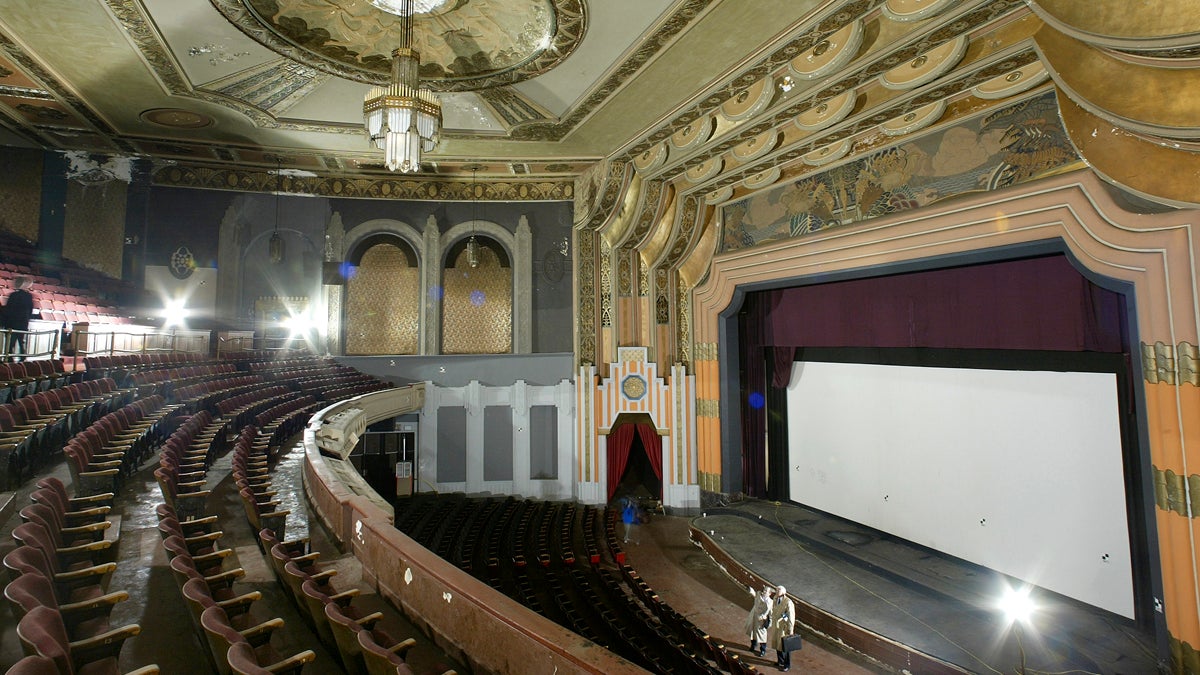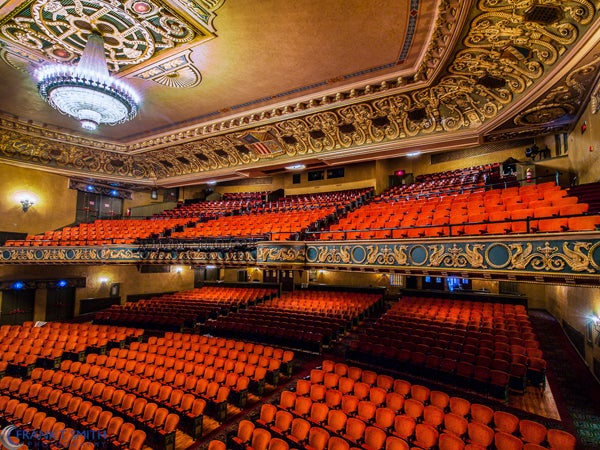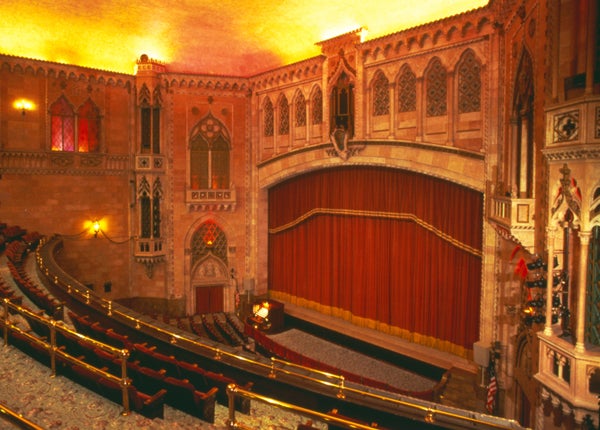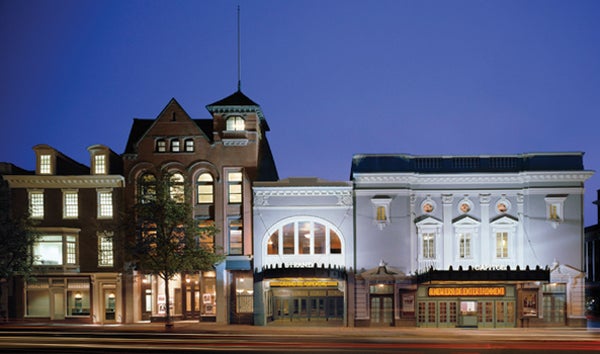How some Pennsylvania theaters have defied the wrecking ball

File image of the interior of Philadelphia's Boyd Theatre from 2005. Today, all that remains is the facade of the theater built in 1928. (AP Photo/George Widman)
Grand theaters in Philadelphia, Easton and Hershey are still standing, though they offer new entertainment.
The last of Philadelphia’s grand movie palaces is all but gone. The 2,300-seat auditorium of the Boyd Theatre, with its ornate ceiling, painted proscenium, murals and chandeliers — gone. A local group is fighting to retain the elegant lobby of mirrors and etched glass. But the only portion of the original building that will be definitely be preserved is the original façade, which was added to the Philadelphia Register of Historic Places in 2009.
The theater, erected in 1928 at the height of exuberant Art Deco design, will be replaced with a 32-story apartment tower of metal and glass, with retail space on the ground floor. The new construction project is welcomed by many businesses on the 1900 block of Chestnut Street that had dealt with a shuttered, blighted building for 13 years.
But preservationists, who had tried long and hard to find a developer who would renovate and repurpose the Boyd interior, lament the loss and wonder why a city like Philadelphia couldn’t keep this theater alive.
Amy E. Ricci, program director at the Preservation Alliance for Greater Philadelphia, said there are many factors that have doomed the historic theaters. “They tend to be large edifices and, in a city, the land is just that much more valuable. They were also designed and built in a time that favored ornate craftsmanship. They require more work and more investment, which makes restoring and retaining them a harder sell for a lot of developers.”
Many other communities in Pennsylvania have managed to rescue their historic theaters, which also have faced the challenges of an evolving entertainment industry, changing consumer habits, and the economics of redevelopment.
Saving the State
The State Theatre in Easton is a contemporary of the Boyd, and the only one of seven great 20th-century theaters in that city still in operation. It was designed in 1925 by Philadelphian W.H. Lee, who looked at Spanish architecture and Florence’s Davanzanti Palace for inspiration. Local Italian artisans were hired to add the frescoes and gilded ceiling to the 1,500-seat auditorium.

The interior of the State Theatre was inspired by a Florentine palace. (Image by Frank Smith)
The State was a vaudeville house before the arrival of the talkies, when it bloomed as a movie palace. A larger screen and stereophonic sound were added in the 1960s. But the frescoes were painted over in the 1970s when the theater became a rock concert venue. By the 1980s, the State was in decline and threatened with demolition.
The Friends of the State Theatre rose from the local community and raised $25,000 to purchase the property. But the building needed millions to cover its restoration. The first phase of the “Renaissance Campaign” in 1986 brought in $1.2 million, which paid for a new stage gridiron, new curtain, lighting controls, fire and smoke alarms and other upgrades. In the second phase of the campaign, the Friends raised $2.5 million to restore the seats, carpeting, ceiling and walls.
In 1992, current State Theatre president Shelley Brown arrived with a background in nonprofit operations and television production. “Since then, we’ve found a niche doing live performances” — Broadway shows, orchestras, and veteran rockers — “but the competition is enormous,” Brown said.
There are 18 venues in the Lehigh Valley region, including the casino in Bethlehem, which vie for headline acts, and “we’re just trying to make our way in that atmosphere.”
The State gets some support from the county and private foundations, and the rest of the operating budget depends on “show profits, if there are any,” Brown said. She has created a development department at the theater that has found a successful strategy to fundraising. “We have targeted our appeals. When we asked for $40,000 for a new curtain, people contributed $40,000 in a heartbeat. Last year we asked for help for a new roof, and we got that in a heartbeat. Now we’re asking them to help fix the plaster.
“But trying to run these old buildings is tough. I’m not surprised that developers can’t take them on,” Brown said. “There is no business plan that makes them work.”
A legacy act
The Hershey Theatre is something of an anomaly, but an interesting example of the role a theater can play in a city.
In 1915, Milton Hershey hired Lancaster architect C. Emlen Urban to design a $3 million Community Center, in addition to Hershey’s original factory and home. The Community Center complex, with the theater as its centerpiece, was completed in 1933, at the height of the Depression. The theater foyer has an arched tile ceiling patterned after St. Mark’s Cathedral in Venice. The grand lobby has a floor laid with polished Italian lava rock and marble walls and arches, and bas-reliefs of pastoral scenes and chariots adorn the ceiling.
Vaudeville performances were presented along with movies in the early years. In the 1940s to ’60s, the Hershey became an active movie palace, with the bill changing two or three times a week. “There were very few dark nights in the house,” said Pam Whitenack, director of the Hershey Community Archives.
The theater had been constructed with a deep stage, fly system, and sophisticated lighting, and it has hosted touring companies and orchestral performances for decades. It also had a strong role in the community since the end of World War II, providing space for celebrations and non-denominational church services held by the Milton Hershey School.

The Hershey serves as performance space for professional shows and local recitals. (Image courtesy of Hershey Community Archives)
There are occasional movie showings, but the theater is primarily a performance hall for concerts, comedians, and shows. In the springtime, area dance schools hold their recitals in the magnificent theater, and the local symphony and chorus are frequent visitors.
The Hershey Theatre has a solid funding structure. It is owned by the Milton S. Hershey Foundation, and part of the Foundation’s endowment goes toward managing the theater. “But a significant portion of the operating expenses come through the shows presented there,” Whitenack said.
Hershey Entertainment & Resorts, a privately held company founded by Milton Hershey in 1927, acts as the booking agent for the theater and helps support operations.
“The Hershey Theatre is unique,” Whitenack said. “It’s part of the things created by Milton Hershey, part of his vision and legacy assets. There’s a lot of respect for that and a strong desire in the community to ensure that they continue.”
A special relationship
Among the competition for the Hershey Theatre is the respected performing arts stage in York, which actually had been two theaters.
The 450-seat Capitol — originally the Theatorium and later the Jackson — was designed by Reinhardt Dempwolf in 1906 as a dance hall; a balcony was added in 1917 when it began showing moving pictures. Next door, the 1,232-seat Strand Theatre, designed by E.C. Horn & Sons with an Italian Renaissance motif, was built in 1925. The Strand cost $1 million to construct, with an interior that incorporated 1,800 pounds of gold leaf, 100 pounds of bronze, and 4,000 pounds of ribbon gold in the plaster moldings.
Both theaters thrived as movie palaces through the 1950s, then began their slow decline and closed in the 1970s.
“They were in line for the wrecking ball,” said Todd Fogdall, president and CEO of the Strand-Capitol Performing Arts Center. “The plan was to raze them and put in a parking lot. But a group of citizens said ‘we can’t have this.’ They put together a concept for renovating and reopening them as a nonprofit performing arts center. That was in 1980, and now we’re in our 35th year.”

The Strand-Capitol Performing Arts Center in York incorporates two early-20th century theaters. (Image courtesy of the Strand-Capitol Performing Arts Center)
The larger theater has served as the home of the York Symphony Orchestra and as a popular venue for Broadway productions, dance performances, concerts and local groups. The Capitol continued as an active movie house until the 1990s, then became a performance space, with a restored 1927 Wurlitzer organ.
The theaters underwent a $17 million renovation in 2002, and the center only recently completed payment on the debt, Fogdall said.
“The community has provided the funds that allowed us to repay the debt. They feel so strongly about these spaces. It’s an exceptional situation in many ways, going back to the group that saved the theaters in the 1970s,” Fogdall said. “There is a special relationship with this community.”
Editor’s note: This article has been corrected to reflect the fact that they Boyd Theatre has been closed for 13 years. It has also been updated to reflect the most recent development plans for the proposed apartment tower at the Boyd Theatre site as of Nov. 30.
WHYY is your source for fact-based, in-depth journalism and information. As a nonprofit organization, we rely on financial support from readers like you. Please give today.


